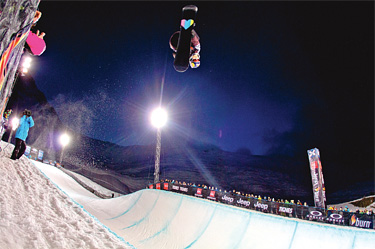Extreme Genre Pushes Video Technology to New Heights
BRISTOL, CONN.—There was a time when flipping a motorcycle on TV wasn't a common occurrence at all.

But then came the "Extreme Games," a mishmash of events like sport climbing and barefoot waterskiing that found a following in the hot, humid clime of Rhode Island and Vermont in the summer of 1995.
Sixteen years later, those early days have been replaced with a well-oiled sports machine known as the X Games, a genre that encompasses both summer and winter sports, and has spawned comparable events like the Red Bull Air Race and Big Wave World Tour. In contrast to the majority of high-end sporting events on broadcast television, the extreme-sports genre found a following from a vociferous youth demographic who flocked to the semi-hazardous, outrageous, no-holds-barred nature of the sports.
That unique blend of youth and risk helped breed an unusual environment of technological innovation at host network ESPN, culminating in the introduction of unique and outlandish technological innovations that may not have found as warm a welcome from more conservative sports like golf or tennis.
Those technical innovations have included the Huck Tower, a 30-foot tower made out of sparkly LED lights that illuminates upward to track the height of an athlete jumping off a skate ramp. The network pioneered the use of Followcams, attaching individual cameras on cameramen and sending them zooming down the slope behind skiers and snowboarders; and perfected the use of the Flycam, a high-speed tracking camera that zips around on a cable to track athletes from above. The games also adopted technologies from its sister sporting events, but gave them their own spin, such as the adoption of slo-motion replays in the form of the Mega Mo, an ultra-slow-motion replay device that records up to 4500 frames per second.
The success of the genre has also led ESPN into similar extreme sport ventures like the Global RallyCross, an off-road rally racing championship that will air this month. Next up for the network is Summer X Games 17, which returns to the Staples Center in Los Angeles, July 29-Aug 1.

Iouri Podladtchikov during the Snowboard SuperPipe Men's Final at the Winter X Games France, March 18. C. Van Hanja/ESPN Images For the last 10 years, Phil Orlins has been a coordinating producer for ESPN's coverage of Summer and Winter X Games. In the last few years, he's dipped his hand into the 3D space as well, handling the network's 3D coverage for the X Games as well as for events like the 2011 Masters, in which ESPN worked with CBS on its 3D coverage.
TV TECHNOLOGY: What are the challenges in covering an extreme sporting event as compared to a more traditional sporting event?
PHIL: When we are covering the X Games we have to be aggressive, utilizing mini cameras to have that kind of unique angle, especially as we're moving into 3D. We have to be much closer at the X Games than we would at the Masters, for example. We've also been pretty aggressive over the years with the Followcams. We are also aggressive in using onboard cameras on snowmobiles.
TVT: What are the challenges between the summer and winter events?
PHIL: I think the Winter X Games has its own set of challenges; to some degree that's the same for broadcast coverage of any winter sports event. You're dealing with mountains, snow and extreme cold. The one thing I'd say that's different [in covering the Winter X Games] is that our terrain is a little more extreme. We're pushing around huge quantities of snow. That's not to take away from the Olympics or downhill racing. But we've got long, steep and fast courses with 30-foot high jumps. We have to first create that and then deal with that expanded terrain in terms of the size and the course we create. We've built a 600-hundred-foot upper pipe for snow mobiles and snowboarding.
TVT: What's at stake—from a technical perspective—when covering an extreme sporting event?
PHIL: When someone is flying 50 feet in the air, and you're on the side of the mountain, you need to find ways to get up to those heights to really see what's happening. That means we bring in a lot of scaffolding, robotic cameras on cables and Flycam runs [an aerial camera on a cable that provides high-speed tracking shots from the air].

Elissa Steamer, Womens Skate Street at X Games 16. Bryce Kanights/Shazamm/ESPN ImagesTVT: Who have been key partners in ESPN's extreme sports coverage?
PHIL: We've certainly relied on VSI [a Southington, Conn.-based post facility] greatly for our transmission, both with the ski Followcams and in-car cams at the Summer X Games. We rely on Fletcher heavily with the robotic setups, which started as an occasional camera. Now we use 12 Fletcher robotic cameras on our race events in winter, covering the course from top to bottom. We set up scaffolding up to 40 feet high. We use the Flycam for aerial shots, more for the winter games than for summer. And for the helmet cams, we use Go Pro [wearable digital cameras].
TVT: Do you think more R&D efforts have been spent on new technologies for the network's extreme sports coverage vs. other sporting events?
PHIL: In every sport you're trying to give the best access you can get for the viewer, the best experience possible. There's more opportunity with the X Games for certain, but those who are doing coverage [for other sports] are trying to still find ways to get us as close as we without obstructing any action. For instance, we put reporters in the rally cars in races in the Summer X Games—that's the kind of conversation that would be a little more complicated than with another organizing body. But hey, we have an empty passenger seat. Let's have the reporter go right in the car. And it took a day to get it approved.
TVT: Is 3D proving to be a smart fit?
PHIL: [The X Games are] as perfect a group of sports as we could have for 3D. It has terrain changes, which are spectacular in 3D. It has a degree of predictability—most events that the athletes fly through have a predictable path. That's gives us a good feel for where the athlete is going. Compare that to football [which is much more unpredictable]. At the X Games, we have the ability to get pretty close when we want to get close. I think those who've the Winter X 3D coverage have been more wowed by that 3D than anything else. It's the top of the line 3D. So 3D will continue for the X Games for the future.
The professional video industry's #1 source for news, trends and product and tech information. Sign up below.
Susan Ashworth is the former editor of TV Technology. In addition to her work covering the broadcast television industry, she has served as editor of two housing finance magazines and written about topics as varied as education, radio, chess, music and sports. Outside of her life as a writer, she recently served as president of a local nonprofit organization supporting girls in baseball.

